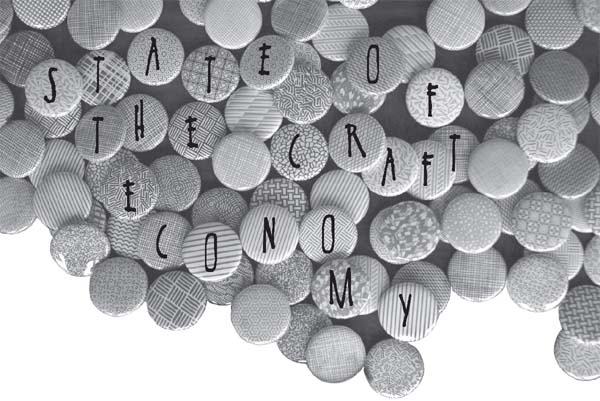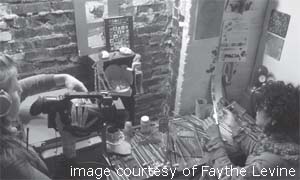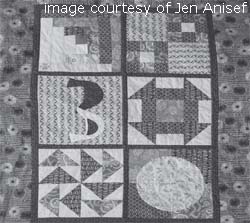The mainstream hasn’t been this interested in the handmade aesthetic since, well, since before there was such a thing as a “handmade aesthetic.” Stores like Urban Outfitters are co-opting the handmade look, particularly with its home accessories such as embroidered pillows, flawed ceramic items and its entire “DIY” department, and Etsy.com, the place for buying and selling handmade goods, reports gangbuster sales despite the economic downturn.
Meanwhile, the media is wondering at the return of craft and zines (note to arts and lifestyle reporters: we never went away, you just forgot about us). In a February Guardian article, longtime music critic Simon Reynolds wrote about his surprise to see that “fanzines” are still being made. “Although it’s hard to quantify, it feels like the fanzine is making a resurgence in the face of digital culture, just like that other analogue format, vinyl,” he wrote. In the article he profiled a few zine creators including Elodie Amandine Roy, the Newcastle-upon-Tyne-based creator of Applejack. Why zines? Reynolds wanted to know. Why not a blog? Roy’s answer was telling: “I wanted to make something that would be visible and material and touchable. I wanted people to be able to read them and keep them somewhere in their house.”
This is why a lot of people turn to craft. Because of the need to see a physical, and not entirely digital, result from one’s efforts. And because it is liberating to want something and then to make it yourself. However, it’s hard to label this “a resurgence,” as Reynolds did. After all, people never really stopped making things. People moved online, they moved more heavily into different forms of “craft,” the focus of attention shifted, but there’s always been a bunch of people willing and able to make their own zines, bind their own books, knit dolls and make their own whoopee cushion accordions (see Broken Pencil #40 for in depth instructions.)
So what’s changed? Why are commercial outlets and social commentators suddenly noticing what’s been happening all along? Well, one thing that we’re seeing is this: with a growth in interest, comes a growth in an interest in cashing in on that interest. In other words, more people are now seeking to make money off of their creations. For a change, mainstream interest doesn’t seem to be thwarting grassroots participation. Instead of dying out, the craft community is feeding off of this mainstream interest and some are making it a living. Will too much interest be the death of craft-as-community, craft-as-hobby, the pleasure of making things for one’s self and one’s friends just because you can?
Over the last few decades, the crafty types have been more philosophically aligned with zine creators and other DIY culture makers than with even artsy home business types. Craft was a way into creativity and community Ð an opportunity to stitch-and-bitch, a chance to be creative, to learn old-school skills that no one values anymore. While that is still true, lately craft has been changing.
Consider Becky Johnson’s transition. Today, Johnson is the proud co-founder of City of Craft (a Toronto-based collective and craft fair) and the brains and brawn behind Sweetie Pie Press (a button making endeavour). Once upon a time, Johnson made zines. But when she was looking to start a home business she saw that the demand wasn’t there for zines the way it was for other forms of craft. “People don’t want zines,” she says. “At least not in a way that is going to support you.” Johnson started making zines in 2001 (and has been crocheting and doing other forms of craft for longer than she can remember), and while she’d like to find time to make zines again in the future, she moved into button making as a job because she could see it sustaining her in a way zines couldn’t. Button makers, knitters and sewers alike are quitting their day jobs and making craft a full time thing, and it has worked. “[Zine making] is not going to be your day job, but buttons can be,” says Johnson. “Even at book fairs people are more excited to buy stuff than books.” This certainly rang true at this years’ Buffalo Small Press Book Fair. It was dominated by book and zine creators but the table that consistently seemed to be swarming with people was the one that offered handmade “softie” stuffed animals. This renewed interest in craft is what some creators are relying on to make a living.
Karyn Valino, owner of The Workroom, a shop in Toronto that offers sewing classes, pay-by-the-hour access to sewing machines and stitch n’ bitch nights, thinks one of the reasons handmade gifts have hit the mainstream, and made crafting a viable living, is that people are looking for something unique. “I think people are more accepting of things that are handmade and imperfect and less manufactured,” says Valino. “You can tell that because certain corporations are trying to mimic that look.” Johnson agrees that people will always want unique items as a symbol of status, but she thinks another aspect of the acceptance of handmade items is that the quality is improving. “I think the people who are making stuff are getting better at making it,” says Johnson. “Or [they’re realizing] if you’re going to sell something at art prices it had better last.”
Another trend helping the sale of crafts despite the failing economy is the popularity of ecological awareness and buying local. Basically, buying handmade alleviates guilt. If you can see the person who is selling you your iPod case or your scarf you know it wasn’t made by slave labour and you figure the materials are ethical too (or at least you have the opportunity to ask if they are). “I have a strong belief in working towards a more sustainable future and though my crafting is only a very small action, the idea of making garments and textiles that are durable and timeless really appeals to me,” says Keeley McLean, a Haligonian crafter who organizes craft events and classes at the Anchor Archive zine library. Also, in environmental terms, you know that your purchase didn’t sit on a truck for thousands of miles using up gallons of gas just to get to your door. Al Gore can tell you more about that.
As for the “recession proof”-ness of crafting, Serah-Marie McMahon, editor of alternative fashion magazine Worn, can see how the slumping economy is good for the sales of certain crafts. “In [this kind of] economy, traditionally, people stop buying big purchase items but they want to buy small luxuries,” she says. This means that while perhaps the more expensive craft items won’t do so well during this slump, little things that are under $100 may do even better. She has seen the sales of Worn increase dramatically lately, and while she thinks some of that has to do with her change in location (from Montreal to Toronto), some of it is also because of the economy. “You compensate for not getting the big things you want with the little things and that lets the craft community shine.”
Others are not so convinced. “I hear a lot of people saying really optimistically that when people do want to spend their hard earned pennies on something they’re actually going to be more inclined to buy something handmade because it’s more meaningful to them,” says Callie Janoff, the founder of Church of Craft. “I think [this] maybe is true for some people and I think it’s a really nice idea, but coming from my own experience, I make a lot of leather craft and I’ve been trying really hard to work through my stash because I can’t actually afford to go out and buy a $250 hide right now.” And this is the sentiment of many crafters. While they’re seeing sales going up at craft fairs, and more craft fairs popping up across North America, this is counterbalanced by the closure of independent stores, and less orders from the stores that remain in business because they can’t afford to keep as much overhead. This may be an alternative economy, but it’s still an economy.
One thing the slumping economy might be doing, however, is boosting the desire to make things yourself. Not only is it cheaper to repair or redesign something new out of something you already have, but it’s also something to do while you’re at home, trying not to spend money. “I think that making something gives people a sense of accomplishment, you feel empowered after completing a project,” says Faythe Levine, director of Handmade Nation and author of the book of the same title. Johnson agrees, sharing the story of the day she felt empowered after her car conked out on the highway. “I went over to the side of the road and I opened the hood and looked at it and was like, ‘maybe that looks loose,'” she remembers. “So I tightened it and then I turned the car over and it started. I was like, ‘how did I just fix my car at the side of the road?'”
The crafting lifestyle slows down life and makes us more self reflective. In this way, craft has taken on almost religious connotations over the last 10 or so years. Believe it or not, the Church of Craft isn’t just a catchy name. Founded in New York in 2000 by Callie Janoff and Trismegista Taylor, their intention wasn’t just to found a group to bring people together in the name of craft. They’ve also sought to highlight the spiritual aspect of crafting. For Janoff, creative activity or making creative decisions is what connects her with a part of herself that she doesn’t understand, and that’s how craft became a spiritual driving force in her life. She incorporated the church in 2003 as a religious corporation and can legally perform weddings as an ordained minister of the Church of Craft. “[Craft] really speaks to my lifestyle and lots of the choices I’ve made about how I want to be in the world,” explains Janoff. “It’s about how I interact with other people, how I want to make my living and the way that I choose to participate more globally as a human being on the planet. All those things are parts of what sustains the interest to continue to be involved in making things and the craft community.”
The more crafting takes on political, social and even spiritual connotations, the more it’s in danger of becoming an activity rife with factions and disagreements. Take the whole issue of selling one’s crafty wares. While there are some makers who are trying to make a living off of their work, there are inevitably others who think crafting should be a personal venture, something you do for yourself and not to please potential buyers. In every community there’s those who want more and those who think that those who want more are selling out.
Then there’s the problem of just how much you should sell your creations for. This is a topic that people who do crafts to sell — even just as a hobby that supplements other income — come back to over and over again. It’s hard to earn a fair price on Etsy and at craft fairs when one person is selling hand sewn purses for $20 while another is actually trying to be paid for their time and the materials used. “This is an old problem,” says Church of Craft’s Janoff. She thinks that the problem stems from a lack of critical thinking about how an individual’s pricing decisions will affect individual sellers across a system like Etsy and what it means for people who are counting on an income from their work. “My opinion has always been that these things are going to sort themselves out,” she says. “People who sell handmade knit hats for $15, they’re just not going to be able to make them for very long and they just won’t be on the market anymore. I have to imagine that the market will sort out this kind of stuff, it’s just going to take some time.”
The fact is that for all the talk about craft being the aesthetic of the recession, people still gravitate to goods with price tags that are closer to Wal-Mart than the art gallery. Johnson says that she’s lucky that she is able to sell her wares (buttons) at affordable prices because of the nature of what she makes. “I think people who are making high-end stuff are having a harder time and aren’t feeling very recession proof. Cheapness is important.”
As for crafts’ lasting effect on the mainstream, perhaps causing more and more people to learn to love to make their own clothes, toys, dishes and little luxuries, McMahon thinks that for those who weren’t early adopters, it’s probably just another passing trend. “I’m sure in five to 10 years it will go out of style and it will be that thing that people used to do,” she says. “There’ll be some people who will still be doing it and then most of the bandwagon people will have gone away and there’ll be something else that’s really cool. Everyone else will be making little movies or whatever it is.”
The handmade aesthetic is hitting home with mainstream audiences. A combination of recession and buy-local environmental awareness is getting more and more people interested in craft. It looks like a good climate for craft and DIY culture. But is it?







He who asks is a fool for five minutes, but he who does not ask remains a fool forever. – Chinese Proverb